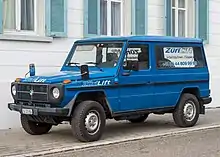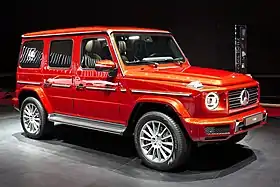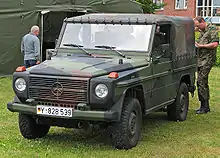Mercedes-Benz G-Class
The Mercedes-Benz G-Class, sometimes called G-Wagen (short for Geländewagen, "terrain vehicle"), is a mid-size four-wheel drive luxury SUV manufactured by Magna Steyr (formerly Steyr-Daimler-Puch) in Austria and sold by Mercedes-Benz. In certain markets, it has been sold under the Puch name as Puch G.
| Mercedes-Benz G-Class | |
|---|---|
 Mercedes-Benz G 500 (W463), second generation | |
| Overview | |
| Manufacturer | Daimler-Benz (1979–1998) DaimlerChrysler (1998–2007) Daimler AG (2007–present) Magna Steyr (2018–present) |
| Also called |
|
| Production |
|
| Assembly |
|
| Body and chassis | |
| Class | Full-size luxury SUV (4×4^2) |
| Related | Peugeot P4 Rheinmetall LIV (SO) (aka AGF) Interim Fast Attack Vehicle Mercedes-Benz W463 G 350 BlueTEC 01 |
The G-Wagen is characterised by its boxy styling and body-on-frame construction. It uses three fully locking differentials, one of the few vehicles to have such a feature.
Despite the introduction of an intended replacement, the unibody SUV Mercedes-Benz GL-Class in 2006, the G-Class is still in production and is one of the longest-produced vehicles in Daimler's history, with a span of 41 years. Only the Unimog surpasses it.[4]

The success and longevity of G-Class has reached another milestone: 400,000th unit was built on 4 December 2020. The 300,000th unit was built three years ago in 2017.[5]
History



The G-class was developed as a military vehicle from a suggestion by the Shah of Iran (at the time a significant Mercedes shareholder) to Mercedes[6] and offered as a civilian version in 1979. In this role it is sometimes referred to as the "Wolf". The Peugeot P4 was a variant made under licence in France with a Peugeot engine. The first military in the world to use it was the Argentine Army (Ejército Argentino) beginning in 1981 with the military model 461.
The development of the G-Class started in 1972 with a cooperative agreement between Daimler-Benz and Steyr-Daimler-Puch in Graz, Austria. Mercedes-Benz engineers in Stuttgart were in charge of design and testing, while the team in Graz developed the production plans. The first wooden model was presented to Daimler-Benz management in 1973, with the first drivable prototype beginning various testing including German coalfields, the Sahara Desert, and the Arctic Circle in 1974. Construction commenced on a new production facility in Graz, where the new cross-country vehicle would be assembled nearly entirely by hand in 1975, with production of the "G Model" beginning in Graz in 1979. In 1980, the Vatican took delivery of a specially made G-Wagen outfitted with a clear thermoplastic top which served as the Popemobile. The “Papa G” later took up permanent residence at the Mercedes-Benz Museum in Stuttgart, Germany.
The first major refinements were introduced in 1981, including an automatic transmission, air conditioning, an auxiliary fuel tank, protective headlamp grilles and a cable winch. Fuel injection became available in 1982, when the 230 GE was introduced in Turin,[7] along with more comfortable and supportive front seats, auxiliary heating, wider tires and fender flares. For 1985, differential locks, central door locking and a tachometer became standard and by 1986 over 50,000 G Models had been produced.
The G-Wagen was facelifted in 1990. In 1989, for the 10th anniversary of the G Model, a new model variant with permanent 4-wheel drive, a wood-trimmed interior and optional Anti-lock Braking System (ABS) debuted at the Frankfurt International Motor Show. Production began the following April. For 1992, a new sub-series for professional users began production. The civilian model began to offer cruise control, a stainless-steel spare-tire cover, running boards and Burl Walnut wood interior trim. The same year, the 100,000th G Model was built in Graz. In 1994, the model line was officially renamed the G-Class. Ventilated front disc brakes and a driver's air bag became standard. In 1996 the automatic transmission became an electronically controlled 5-speed unit. Headlamp washers, cruise control and a front passenger's air bag were added. In 1998, the range-topping G 500 with a 296 hp V 8 was introduced for series production.
For 1999 a limited run of V 8 powered "G 500 Classic" special editions marked the model's 20th anniversary. A multifunction steering wheel was added to all models. Later in the year, the new G 55 AMG debuts as the most powerful G-Class yet, with 354 hp. The U.S. market launch of the G-Class took place in 2001. New alloy wheels, a chrome grille and body-colour bumpers plus a more luxurious cabin were introduced. New dynamic control systems included the Electronic Stability Program (ESP), Brake Assist and the 4 wheel Electronic Traction System (4 ETS). The G 55 AMG was upgraded in 2004 with a supercharged V 8 engine developing 476 hp. In Siberia in 2006, a documentary filmmaker was the first foreigner to reach the world's coldest region with a passenger vehicle in winter, driving a stock G 500 nearly 19,000 km without a single breakdown, in temperatures as frigid as −63˚F/-53 °C.
A new version was expected for 2007, but the new GL-Class did not replace the G-Wagen, and it will continue to be hand-built in Graz, Austria at an annual production of 4,000 to 6,000 units. In February 2009, Magna Steyr, an operating unit of Magna International, announced that it signed an agreement with Daimler AG to extend the production of the Mercedes-Benz G-Class at Magna Steyr in Graz, Austria until 2015. Besides the production, the further development of the G-Class by Daimler's subsidiary Mercedes-Benz Consult Graz since 1992.[8]
W460 (1979–1992)
| W460 | |
|---|---|
 | |
| Overview | |
| Production | 1979–1990 |
| Body and chassis | |
| Body style | 2-door SWB convertible 2-door cab chassis (pickup truck) 3-door SWB station wagon 3-door SWB panel van 3-door LWB station wagon 3-door LWB panel van 5-door LWB station wagon |
| Layout | Front engine, four-wheel drive |
| Platform | Mercedes-Benz W460 |
| Powertrain | |
| Engine | 2.0L M 102.964 E20 I4 2.3L M 115.973 I4 2.6L M 115 2.6 Brabus I4 2.8L M 110.994 I6 2.4L OM 616 I4 diesel 2.5L OM 602 I5 diesel 3.0L OM 617 I5 diesel |
| Transmission | 4-speed manual 5-speed manual 4-speed 720.1 (W4A 018) automatic |
| Dimensions | |
| Wheelbase | 2,400 mm (94.5 in) (2-door) 2,850 mm (112.2 in) (4-door) |
W460 was introduced at a press event held at the off-road proving ground in Toulon, France. W460 went on sale in September 1979 with three engine choices and five body variants. Over the decade, the engine and transmission choices were expanded or updated along with more and more optional extra cost creature comforts (air conditioning, automatic transmission, power windows, etc.).
G-Wagen gained the global fame in 1980 when Mercedes-Benz built a Popemobile based on 230 G cabriolet during the first visit of Pope John Paul II in Germany.
Mercedes-Benz never exported G-Wagen officially to the United States because it was considered more of utilitian vehicle and didn't fit the American perception of what Mercedes-Benz was. During the 1980s, the grey import specialists brought W460 to the United States and modified them to meet the US regulations. In 1988, the new federal law, Motor Vehicle Safety Compliance Act, closed the loopholes and tightened up the regulations for grey imports, making it more difficult and more expensive for the registered importers to federalise W460 in a very small number. The other issue was severely underpowered engines in 230 GE, 280 GE, and 300 GD might not appeal to the Americans as it was the case with Mercedes-Benz 380 SEL in the early 1980s.
200 GE was built specifically for Italian markets and other markets where the heavy tax penalty was incurred for engines larger than 2 litres. 300 GD was the most popular model while 280 GE the most powerful. Despite the availability of turbocharged diesel engine in other Mercedes-Benz vehicles, it was never fitted to G-Wagen W460.
The rarest W460 variants were 230 GE 2.6 Brabus (1989–?), 280 GE AMG (specific years not given), and 560 GE (1993). Brabus increased the engine displacement of 2.3-litre four-cylinder inline engine to 2.6 litres, increasing the power to 114 kW (155 PS; 153 bhp). AMG modified the 2.8-litre six-cylinder inline petrol engine for more power, 134 kW (182 PS; 180 bhp). No further production information about price and number of units built were established. Only two units of 560 GE were built in 1993 as part of feasibility study that resulted in a limited series of W463 500 GE for 1993–1994 and W463 G 500 from 1998 on.[9]
G-Wagen W462 ELBO (1988–?)
This version is assembled from CDK by ELBO, formerly a Steyr-Daimler-Puch branch division, in Thessaloniki, Greece for Greek Army. Additionally, the CDK was also assembled at Mercedes-Benz Aksaray plant in Turkey. The engine options were 2.3-litre four-cylinder inline petrol and later 2.9-litre five-cylinder inline diesel.
Peugeot P4 VLTT (1981–1988)
The W460 was assembled in France under licence by Peugeot for the French Army with Peugeot engine and transmission from the 504 and 604 respectively as well as its own seats and wiring system. The front differential gear lock was omitted because Peugeot used its own axles. They are easily identified by rectangle headlamps.
Puch G (1979–2000)
The agreement between Daimler-Benz AG and Steyr-Daimler-Puch stipulated that G-Wagen sold in Austria, Switzerland, Yugoslavia (and its successor states: Bosnia-Herzegovina, Croatia, Macedonia, Serbia, and Slovenia), Mongolia, and Eastern European COMECON countries was called Puch G and elsewhere as Mercedes-Benz G-Wagen/G-Class. The reason for different branding was due to Puch's reputation for its all-terrain vehicles, Haflinger and Pinzgauer. Since the agreement expired in 2000, the consumers could order the retrofit kit from Magna's Puch Competence Centre to replace the Mercedes-Benz brands with Puch emblems.[10]
For the Pope John Paul II's visit to Austria in 1983, Puch emblems was used on the Papamobile instead.
Engines
| Model | Years | Configuration | Displacement | Power | Torque | 0–100 km/h (0-62 mph) | Top speed | Fuel consumption/efficiency (EU-norm-urban, 90 km/h, 120 km/h) |
|---|---|---|---|---|---|---|---|---|
| Petrol engines | ||||||||
| 200 GE (Italy only) | 1986-1991 | I4 (M 102.964 E20) | 1,997 cc | 87 kW (118 PS; 117 bhp) at 5,200 rpm | 178 N⋅m (131 lb⋅ft) at 3,500 rpm | 18 seconds | 140 km/h (87 mph) | 16.0 L/100 km (14.7 mpg‑US) — — |
| 230 G | 1979–1982 | I4 (M 115.973) | 2,307 cc | 67 kW (91 PS; 90 bhp) at 5,000 rpm | 167 N⋅m (123 lb⋅ft) at 3,500 rpm | 26 seconds | 128 km/h (80 mph) | 19.8 L/100 km (11.9 mpg‑US) 13.5 L/100 km (17.4 mpg‑US) 19.8 L/100 km (11.9 mpg‑US) |
| 230 GE | 1972–1990 | I4 (M 115.973 E23) | 2,299 cc | 93 kW (126 PS; 125 bhp) at 5,100 rpm | 192 N⋅m (142 lb⋅ft) at 4,000 rpm | 17 seconds | 152 km/h (94 mph) | 17.2 L/100 km (13.7 mpg‑US) 12.2 L/100 km (19.3 mpg‑US) 16.2 L/100 km (14.5 mpg‑US) |
| 230 GE 2.6 Brabus | 1989–1990 | I4 (M 115.973 2.6 Brabus) | 2,587 cc | 114 kW (155 PS; 153 bhp) at 5,500 rpm | 260 N⋅m (192 lb⋅ft) at 3,300 rpm | 14.7 seconds | 158 km/h (98 mph) | 17.2 L/100 km (13.7 mpg‑US) 12.2 L/100 km (19.3 mpg‑US) 16.2 L/100 km (14.5 mpg‑US) |
| 280 GE | 1979–1990 | I6 (M 110.994) | 2,746 cc | 116 kW (158 PS; 156 bhp) at 5,250 rpm | 226 N⋅m (167 lb⋅ft) at 4,250 rpm | 14 seconds | 165 km/h (103 mph) | 22.4 L/100 km (10.5 mpg‑US) 14.0 L/100 km (16.8 mpg‑US) 18.8 L/100 km (12.5 mpg‑US) |
| 280 GE AMG | 1979–1990 | I6 (M 110.994) | 2,746 cc | 134 kW (182 PS; 180 bhp) at 5,250 rpm | 226 N⋅m (167 lb⋅ft) at 4,250 rpm | 14 seconds | 165 km/h (103 mph) | 22.4 L/100 km (10.5 mpg‑US) 14.0 L/100 km (16.8 mpg‑US) 18.8 L/100 km (12.5 mpg‑US) |
| Diesel engines | ||||||||
| 240 GD | 1979–1988 | I4 (OM 616.936, OM 616.938, OM 616.941) | 2,399 cc | 53 kW (72 PS; 71 bhp) at 4,400 rpm | 137 N⋅m (101 lb⋅ft) at 2,400 rpm | 32 seconds | 115 km/h (71 mph) | 14.4 L/100 km (16.3 mpg‑US) 12.0 L/100 km (19.6 mpg‑US) — |
| 250 GD | 1988–1991 | I5 (OM 602.930) | 2,497 cc | 63 kW (86 PS; 84 bhp) at 5,150 rpm | 154 N⋅m (114 lb⋅ft) at 2,200–2,800 rpm | 27 seconds | 127 km/h (79 mph) | 12.8 L/100 km (18.4 mpg‑US) 10.0 L/100 km (24 mpg‑US) — |
| 300 GD | 1979–1991 | I5 (OM 617.931, OM 617.932) | 2,998 cc | 65 kW (88 PS; 87 bhp) at 5,250 rpm | 226 N⋅m (167 lb⋅ft) at 4,250 rpm | 27 seconds | 127 km/h (79 mph) | 14.6 L/100 km (16.1 mpg‑US) 11.7 L/100 km (20.1 mpg‑US) 18.8 L/100 km (12.5 mpg‑US) |
W461 (1992–present)
| W461 | |
|---|---|
 Mercedes G-Class C 280 CDI EDITION.30 PUR | |
| Overview | |
| Production | 1992–present (military variant)[11] Civilian variant produced until 2014 |
| Body and chassis | |
| Body style | 2-door SWB convertible 2-door cab chassis (pickup truck) 3-door SWB panel van 3-door LWB panel van 5-door LWB station wagon |
| Layout | Front engine, four-wheel drive |
| Platform | Mercedes-Benz W461 |
| Powertrain | |
| Engine | 2.3L M 102 E 23 I4 2.5L OM 602.930 I5 diesel 2.7L OM 612 DE 27 LA I5 turbodiesel 2.9L OM 602 D 29 I5 diesel 2.9L OM 602 DE 29 LA I5 turbodiesel 3.0L OM 642 DE 30 LA red. V6 turbodiesel |
| Transmission | 4-speed 720.1 (W4A 018) automatic 5-speed manual 4-speed manual |
| Dimensions | |
| Wheelbase | 2,400 mm (94.5 in) (2-door) 2,850 mm (112.2 in) (4-door) |
After the new W463 was introduced in 1989 with extensively updated chassis and revised front end, the production of W460 ended in 1991 and was replaced by W461. The W461 is essentially the chassis of W460 with powertrain of W463 and retains the W460 body. While W463 is catered to the consumers who seek more creature comfort and better driving dynamics, W461 is built specifically for military, public authorities, and non-governmental organisations. That included the 24-voltage electrical system for W461. The W461 for military, public authorities, and non-governmental organisations is too extensive and wide-ranging to list here.
During the 1990s, W461 was offered with 2.3-litre four inline petrol engine and 2.9-litre five inline diesel engine from 1992 to 2001. From 2001 to 2014, the W461 model for military and public authorities were offered with 2.7-litre five inline turbodiesel engine and later with 3.0-litre V6 turbodiesel engine. They were called G 270 CDI Worker (2001–2006) and G 280 CDI Worker (2007-2009) respectively.
Over the years, Mercedes-Benz had introduced the civilian version of W461, built in limited series and for limited period of time. They targeted primarily the consumers who wanted the "stripped down" version and did not need the creature comfort. The engine choice was often limited to one type, namely diesel engine, per series. Those editions were named as PUR or Professional.
In 2009, Mercedes-Benz, celebrating the 30-year anniversary of G-Class, introduced G 280 CDI EDITION.30 PUR based on five-door long wheelbase station wagon. The consumers could order theirs with "Off-Road Package 1" or "Off-Road Package 2". The passenger compartment had four seats upholstered in hard-wearing fabric or vinyl, rubber floor coverings, spray-protected/water-resistant controls, drainage apertures in the footwells, and wood floor in the load compartment with load lashing lugs and rails. The dashboard received new instrument cluster from W463 and dual air bags. The climate control remained manually operated so were the window winders and locks. The exterior received the flexible wheel arch flaring, protective grilles for headlamps, taillamps, and front turn signal indicators, a walk-on hood/bonnet for easy access to the optional roof rack, a towing lug attached to the front bumper, and two-section barn doors in the rear.
The success of limited series "EDITION.30 PUR" led to G 280 CDI Professional in 2009 and its successor, G 300 CDI Professional, in 2010. Initially, G 280 CDI Professional was limited to five-door long wheelbase station wagon before the body variants were expanded to five different body variations: three-door long wheelbase panel van (Kastenwagen in German), five-door long wheelbase station wagon, two-door cabriolet, and two-door and four-door cab chassis truck (Pritschenwagen in German) for G 300 CDI Professional.[12] The production of the civilian variant continued until 2014. However, the military variant continues to this day.[13]
_%E2%80%93_Frontansicht%252C_7._August_2012%252C_Stuttgart.jpg.webp)
_%E2%80%93_Heckansicht%252C_7._August_2012%252C_Stuttgart.jpg.webp)
_%E2%80%93_Frontansicht%252C_7._August_2012%252C_Stuttgart.jpg.webp)
_%E2%80%93_Heckansicht%252C_7._August_2012%252C_Stuttgart.jpg.webp)
.1.JPEG.webp)
.2.jpg.webp)
Engines
| Model | Years | Configuration | Displacement | Power | Torque | 0–100 km/h (0-62 mph) | Top speed | Fuel consumption/efficiency (EU-norm-urban, extra urban, combined) |
|---|---|---|---|---|---|---|---|---|
| Petrol engines | ||||||||
| 230 GE G 230 |
1992–2001 | I4 (M 102 E 23) | 2,298 cc | 92 kW (125 PS; 123 bhp) at 5,100 rpm | 188 N⋅m (139 lb⋅ft) at 3,500 rpm | 19–20 seconds | 144–147 km/h (89–91 mph) | 17.2 L/100 km (13.7 mpg‑US) 12.2 L/100 km (19.3 mpg‑US) 16.2 L/100 km (14.5 mpg‑US) |
| Diesel engines | ||||||||
| 250 GD "Wolf" (Bundeswehr) |
1990–1991 | I5 (OM 602.930) | 2,497 cc | 68 kW (92 PS; 91 bhp) at 4,600 rpm | 154 N⋅m (114 lb⋅ft) at 2,200–2,800 rpm | 27 seconds | 127 km/h (79 mph) | 12.8 L/100 km (18.4 mpg‑US) 10.0 L/100 km (24 mpg‑US) — |
| G 270 CDI Worker (Military) | 2001–2006 | I5 (OM 612 DE 27 LA) | 2,685 cc | 115 kW (156 PS; 154 bhp) at 3,800 rpm | 400 N⋅m (295 lb⋅ft) at 1,800–2,400 rpm | — | — | — |
| G 280 CDI Worker (Military) | 2007–2014 | V6 turbo (OM 642 DE 30 LA red.) | 2,987 cc | 135 kW (184 PS; 181 bhp) at 3,800 rpm | 400 N⋅m (295 lb⋅ft) at 1,600–2,600 rpm | — | 120 km/h (75 mph) | — |
| G 280 CDI EDITION.30PUR | 2009 | 13 seconds | 160 km/h (99 mph) | 14.1 L/100 km (16.7 mpg‑US) 9.8 L/100 km (24 mpg‑US) 11.4 L/100 km (20.6 mpg‑US)* | ||||
| G 280 CDI Professional | 2009 | 18 seconds | 160 km/h (99 mph) | |||||
| G 300 CDI Professional | 2010–2014 | |||||||
| 290 GD G 290 DIESEL |
1992–1997 | I5 (OM 602 D 29) | 2,874 cc | 70 kW (95 PS; 94 bhp) at 4,000 rpm | 192 N⋅m (142 lb⋅ft) at 2,300 rpm | 25–27 seconds | 135–138 km/h (84–86 mph) | 13.5 L/100 km (17.4 mpg‑US) 9.8 L/100 km (24 mpg‑US) 12.6 L/100 km (18.7 mpg‑US) |
| 290 GD T G 290 TURBODIESEL |
1998–2001 | I5 (OM 602 DE 29 LA) | 2,874 cc | 89 kW (121 PS; 119 bhp) at 3,800 rpm | 280 N⋅m (207 lb⋅ft) at 1,900–2,300 rpm | 17.2 seconds | 137 km/h (85 mph) | 12.0 L/100 km (19.6 mpg‑US) 10.0 L/100 km (24 mpg‑US) 10.9 L/100 km (21.6 mpg‑US) |
G-Class W463, first generation (1990–2018)
| W463 | |
|---|---|
 | |
| Overview | |
| Production | 1990–2018 |
| Body and chassis | |
| Body style | 3-door SWB 2-door SWB convertible 5-door LWB station wagon |
| Layout | Front engine, four-wheel drive |
| Platform | Mercedes-Benz W463 |
| Related | KSU Gazal-1 |
| Powertrain | |
| Engine | 2.0L M 102.965 E 20 KAT I4 2.3L M 102.989 E 23 KAT I4 3.0L M 103.987 E 30 KAT I6 3.2L M 104.996 E 32 I6 3.2L M 112.945 E 32 V6 3.6L M 104.992 E 36 I6 4.0L M 176 DE 40 AL twin-turbo V8 5.0L M 117.965 E 50 V8 5.0L M 113.965 E 50 V8 5.4L M 113 E 55 V8 5.4L M 113 E 55 ML supercharged V8 5.5L M 273 KE 55 V8 5.5L M 157 DE 55 twin-turbo V8 6.0L M 117.965 E 50 bored to 6.0 litres[14] V8 6.0L M 279 E 60 AL twin-turbo V12 6.3L M 137 E 63 V12 2.5L OM 602.931 D 25 I5 Diesel 2.7L OM 612.965 DE 27 LA turbo I5 Diesel 3.0L OM 603.931 D 30 I6 Diesel 3.0L OM 606.964 D 30 LA turbo I6 Diesel 3.0L OM 642 DE 30 LA V6 turbo Diesel 3.5L OM 603.972 D 35 A turbo I6 Diesel 4.0 OM 628.962 DE 40 LA biturbo V8 Diesel |
| Transmission | |
| Dimensions | |
| Wheelbase | 2,400 mm (94.5 in) (2-door) 2,850 mm (112.2 in) (4-door) |
| Length | Pre-2003: 4,661 mm (183.5 in) 2004–09: 4,714 mm (185.6 in) (LWB) 2010–18: 4,686 mm (184.5 in) |
| Width | Pre-2003: 1,760 mm (69.3 in) 2004–09: 1,811 mm (71.3 in) 2004–09 AMG: 1,864 mm (73.4 in) 2010–18: 1,824 mm (71.8 in) 2010–18 AMG: 1,857 mm (73.1 in) |
| Height | Pre-2003: 1,836 mm (72.3 in) 2004–09: 1,976 mm (77.8 in) 2010–18: 1,930 mm (76.0 in) |
| Kerb weight | 2,580 kg (5,690 lb) (G 55 AMG) |
For 1990, W460 was extensively revised, and a new chassis number, W463, was assigned. W463 moved G-Class from the spartan and utilitarian purpose to the luxury model on par of Mercedes-Benz S-Class and luxurious Range Rover. Thus, no three-door panel vans in short and long wheelbase lengths as well as barn doors in the rear were offered for W463: those features are exclusive to W461. The W461 continued in production as military and utilitarian vehicles for the government agencies and non-government organisations.
The exterior was revised as to smoothen out the front end. The front fenders/wings are vertically flattened out at the front underneath headlamps. The fender flares and front end (cooling grille and headlamp bezels) are painted in body colour. The headlamps have square and slightly recessed bezels. The cooling grille is narrower as to give space for front numberplate attached to the top of bumper. The front bumpers are form-fitted and have integrated fog lamps while the rear bumpers have the integrated red rear fog lamp and white reverse lamp. The fuel filler is now covered by panel. The side running boards are made a standard fitment. The external rear view mirrors have new housing that pivots on anchors attached to the front doors. New revised taillamps without white reverse lamps were fitted in the rear.
The interior was significantly updated with wood trim and leather upholstery for the first time. The centre console is smoothened out and better integrated with dashboard. The lower part of dashboard is covered in rubber pads for better knee protection in an event of the frontal collision. The electric differential lock switches are placed prominently in the middle of dashboard with other electric switches. The instrument cluster has smoother and more curving housing that meets the dashboard fluidly. The gauges are integrated into one panel rather than a few separate gauges attached to the instrument cluster. Climate control panel was revised to include the temperature and fan speed dials. The door panels are fully trimmed with ruffled leather paneling and soft paddings. The seats are more plush and have several defined cushions along with lumbar support.
The new features included ABS and full-time four-wheel-drive with electrically locking differentials. The engines were carried over from W460/W461, including 200 GE, 230 GE, and 300 GE for petrol engines along with 250 GD and 300 GD for diesel engines. In 1994, the Geländewagen was renamed as G-Class when the model names was revised to reflect the new corporate nomeculate.
When Mercedes-Benz didn't consider selling the G-Class in the United States for a long time, a small registered importer based in New Mexico, Europa International, Inc., began the expensive process of certifying and modifying the G-Class for the US market and started selling them in 1993. When the new G 500 was introduced in 1998, Europa International sought and received the "small-volume manufacturer status", allowing the company to be exclusive importer and distributor of G 500 in the United States. The sales success of G 500 was attributed to Europa International's clever marketing toward high-end luxury clientele and led Mercedes-Benz to the decision of purchasing the distribution rights and including G-Class in its official US model ranges.[15]
The first generation W463 had the widest range of engines ever fitted to Mercedes-Benz vehicles during its entire 28-year model run: from four to twelve cylinders; and from naturally aspiration to supercharger, turbo, and twin turbo. Toward the end of first-generation model run, W463 had the highest number of paint colour options at 22, including the bright and intense colours as part of Crazy Color Edition.
Models
W463 had the highest number of body variations and derivations of any post-war Mercedes-Benz:
- two-door cabriolet
- three-door station wagon with short wheelbase
- four-door pickup truck with six wheels (Mercedes-AMG G 63 6x6)
- four-door cabriolet with extended wheelbase (Mercedes-Maybach G 650 Landaulet)
- five-door station wagon with long wheelbase
- five-door station wagon with extended wheelbase (custom built by AMG)
- five-door station wagon with long wheelbase and widened track (Mercedes-Benz G 500 4x4²)
500 GE (1993–1994)
A significant model was 500 GE with the first-ever V8 engine for G-Class. It was produced in a limited number from 1993 to 1994 and in 5-door long wheelbase station wagon only. The V8 engine wasn't reintroduced until 1998 when G 500 entered into a regular production.
Grand Edition (2006)
The 500 units of G 500 and G 55 AMG Grand Edition were built and shipped to the United States when Mercedes-Benz decided to end the sales of G-Class in the United States for 2006 before rescinding its decision. The exterior had an exclusive Allanite Grey Magno metallic paint finish and brushed aluminium trim stripes with "Grand Edition" lettering. The interior had matte-silk wood trim on dashboard and centre console, designo exclusive leather upholstery, and an door sills with illuminated "Grand Edition" lettering.
G 500 Guard (2009–2018)
It is an armoured version of long wheelbase G 500 five-door station wagon with bullet resistance level FB6 or FB7.[16]
G-Class LIMITED.30 (2009)
LIMITED.30 model is a special edition, celebrating the 30-year anniversary of Geländerwagen (1979–2009). This edition includes designo platinum black paint finish, specially designed light-alloy wheels and EDITION30 lettering on the wings. The interior has designo leather in the colour "chablis" and designo trim in anthracite poplar wood.[17]
G 55 AMG KOMPRESSOR "Edition 79" (2009)
Like LIMITED.30 special edition, "Edition 79" is exclusive to Middle East market, celebrating the sales launch in 1979. This edition includes designo magno alanite grey paint finish, a crash bar at the front, carbon fibre side trim stripes, 19-inch AMG wheels with titanium finish, chrome protection grilles for front turn signal indicators, designo leather upholstery in black/sand colour, carbon fibre dashboard and centre console trims, Edition logo "1 out of 79" placed in front of gear selector. The vehicle was unveiled in 2009 Dubai International Motor Show.[18]
BA3 Final Edition and Edition Selection (2011)
The BA3 Final Edition was launched in 2011 to mark the final production run of three-door short wheelbase station wagon. The single model variation was G 350 CDI BlueTEC. This farewell special is distinguished by body-coloured AMG flared wheel arches with 5-twin-spoke light-alloy wheels, carbon optics stripes, an AMG radiator grille, 18-inch alloys, and extra chrome trims inside and outside, black leather interior offset by walnut burr veneers and ambient lighting.
At the same time, Mercedes-Benz offered the "Edition Select" special model for the five-door model, G 500. Edition Selection applies the same special edition treatment to G 500/G 550 even though the five-door long wheelbase station wagon would continue for several more years.[19]
G 55 AMG long "mastermind" Limited (2012)
As a brand awareness collaboration for the Fashion Week, Mercedes-Benz Japan and mastermind JAPAN built five units for Japanese market. Externally, the chrome trims and wheels were done in black paint finish, and two stickers affixed to the side panels in the rear. The mastermind JAPAN skull and bone badges were affixed to the headrests and spare wheel cover. The interior was done in black leather trim with roof liner done in light grey Alcantara.[20]
G 550 Night Edition (2013–2015)
Exclusive to Japanese market, 100 units of G 550 Night Edition were produced with black paint finish, AMG badge on the front fenders/wings, and five twin-spoke aluminium wheels finished in titanium grey colour. Two choices of interior colours were offered: porcelain white (60 units) and classic red (40 units). The dashboard and centre console were trimmed with designo piano lacquer black wood. The roof liner was Alcantara in anthracite colour. The sales price was ¥13,900,000 JPY[21]
G-Class Cabriolet "Final Edition 200" (2013–2014)
To commemorate the production end of two-door cabriolet, Mercedes-Benz introduced the "Final Edition 200" with G 500 being only model variation. All of 200 units had been sold out prior to its premiere at 2013 Frankfurt Auto Show. Externally, the soft top and tonneau cover are in beige colour; radiator grille in chrome; 5-spoke light-alloy wheels in titanium grey; and "Final Edition 200" badge on B-pillar. The interior received the designo leather seats and door panels in ecru colour with black trim, satin-finished light brown poplar wood trim, and AMG performance steering wheel.[22]
G 500 4×4²

Continuing with the G 63 AMG 6×6 formula, Mercedes-Benz introduced the G 500 4×4², using the body of long wheelbase 5-door station wagon on shortened chassis from G 63 AMG 6×6. G500 4×4² along with G 500/G 550 received a new 4.0-litre biturbo V8 (M176), putting out 310 kW (416 hp). The exterior is same as Mercedes-AMG G 63 and G 65 despite G 500 4×4² not being a Mercedes-AMG edition.[23]
Mercedes-Maybach G 650 Landaulet (2017)
Following the success of G 63 AMG 6×6 and G 500 4×4², Mercedes-Benz introduced the first SUV under the sub-brand name Mercedes-Maybach at Geneva Motor Show in March 2017.[24] G 650 Landaulet used the extended chassis with the portal axles and raised suspension system from G 500 4×4². The rear end of G 650 Landaulet was built from the rear part of W463 cabriolet with folding fabric roof covering the rear half of body behind the B-pillar. The rear passenger doors with no wheel-opening cut-out were from the G 55 with extended wheelbase (2001). The front end is from Mercedes-AMG G 65 with more chrome trims. The light alloy wheels and extendable side running boards are chrome plated. The powertrain is from G 65 with 463 kW (621 hp) biturbo V12.
The interior is supplicated in ultimate luxury as found in Mercedes-Maybach GLS-Class and S-Class. Like the original Maybach 62 Landaulet, a division wall is installed behind the driver and front passenger. The second row seats are moved further back from the rear passenger doors and are same rear seats in from Mercedes-Maybach S-Class. A second set of control panel and centre console is installed behind the division wall toward the rear. The dashboard above the second set is one set of two front passenger's dashboard with glove box and hold two large LED monitors.
The sales price was €749,700, and the production was limited to 99 units.[25]

.jpg.webp)
500 GE 6.0 AMG (1993-1995)
For the first time, an AMG version of G-Class was offered in 1993 with 500 GE 6.0 AMG. The M 117.965 E 50 engine was bored from 5.0 to 6.0 litres, outputting 243 kW (326 hp) and 525 N⋅m (387 lb⋅ft). The increased output did not make 500 GE 6.0 AMG much faster with 10.9 seconds for 0–100 km/h. Only thirteen units were built in Long Wheel Base , Only One Unit in Short Wheel Base . [26][27][14]
G 36 AMG (1994–1997)
After AMG entered into the co-operation with Mercedes-Benz in 1993, the G 36 AMG was introduced and fitted with M104.992, same engine found in C 36 AMG and E 36 AMG.
G 63 AMG V12 (2002)
The G 63 AMG V12 was very limited production run with only five units built in 2002. It was the first G-Class with V12 engine before Mercedes-AMG officially introduced more powerful G 65 AMG. The engine produced 326 kW (437 hp) and propelled G 63 AMG to 100 km/h in 6.5 seconds.
G 55 AMG (2002–2003) and G 55 AMG Kompressor (2004–2012)

Citing the sales success of G 500 in the United States and the absorption of AMG into DaimlerChrysler AG, Mercedes-Benz began to expand the AMG versions to several models, including G-Class. To coincide with the official launch of G-Class in the United States, Mercedes-Benz introduced G 55 AMG along with G 500 in 2001 for 2002 model year. The G 55 AMG visually did not differ from G 500 other than side exhaust pipes, wider tyres, AMG five-spoke wheels, chrome tip at bottom of front bumper, and AMG lettering in the rear. G 55 AMG became the favourite of celebrities and wealthy people.
For 2005 model year, AMG revised G 55 AMG by adding the supercharger to the 5.4-litre V8 engine, increasing the output to 350 kW (469 hp). To differentiate G 55 AMG KOMPRESSOR from G 500 visually, AMG changed the radiator grille to three thick fins, added the embossed metal KOMPRESSOR lettering underneath V8 badge on the front fenders/wings, and introduced new light-alloy wheels in titanium grey and three new metallic paint colours (Calcite White, Periclase Green, and Teallite Blue). The 0–100 km/h acceleration is reduced from 7.4 to 5.6 seconds. Yet, the top speed remained at 210 km/h. The engine was upgraded again for 2006 to 368 kW (493 hp) then again to 373 kW (500 hp) for 2008.
G 63 AMG (2012–2018)

The supercharged 5.4-litre V8 was replaced by the new 5.5-litre biturbo V8 for 2012 for better fuel consumption and lower emission. AMG made some more changes to the exterior as to give G 63 AMG more "brawl" appearance: single horizontal fin with twin chrome edges in the middle of radiator grille with more prominent three-point star ornament in the middle; new light-alloy wheel design; three enlarged airflow inlets on both sides and in middle of front bumper; vertical chrome stripes cover the small bumper guards; exterior rear-view mirrors are same as in GL-Class and ML-Class. The mechanical upgrade was AMG sports exhaust system with high-gloss chrome inserts, larger AMG high performance brakes with six-piston fixed calipers for front brakes from ML 63 AMG, and revised suspension and damper settings for more dynamic handling characteristics. The new E-SELECT gear selector from Mercedes-Benz SLS replaced the standard gear selector.
For 2015, the name was changed to Mercedes-AMG G 63.
G 65 AMG (2012–2018)
The G 63 AMG V12, built in 2002, demonstrated the feasibility of installing the V12 engine in G-Class. The new G 65 AMG was introduced at the same time as G 63 AMG, making G 65 AMG the third passenger SUV to have V12 engine with Lamborghini LM002 (built from 1986 to 1993) being the first one. G 65 AMG was equipped the same as G 63 AMG other than minor cosmetic difference with V12 BITURBO on the side of front fenders/wings and floor mats and seat backs with V12 badges.
Like G 63, the name was changed to Mercedes-AMG G 65 for 2015.
G 63 AMG 6×6 (2013–2015)
To mark the thirtieth anniversary of G-Wagen production, Mercedes-Benz introduced the new stretched version with six-wheel-drive system and portal axles.[28][29] G 63 AMG 6×6 was derived from a model developed specifically for the Australian Army in 2007. Despite the heavy weight and large dimension, G 63 AMG 6×6 could accelerate to 100 km/h in six seconds and reach a top speed of 160 km/h.
The consumer reception to the G 63 AMG 6×6 was stronger than anticipated, and Mercedes-Benz sold slightly more than 100 units, with the last customer delivery taking place in May 2015.[30]

.jpg.webp)


.jpg.webp)
Mercedes-Benz G-Wagon Light Armoured Patrol Vehicle 6.X CONCEPT (2010)
It is an armoured patrol vehicle developed with EADS, based on LAPV 5.4. It included a diesel engine, 1.3 tonnes cargo capacity, monocoque full steel body, compact 2,850 mm (112.2 in) wheelbase, modular armour plate and mine deflector plate underneath floor, adjustable variable lift front and rear coil-over air shock absorbers with maximum 450 mm (17.7 in) of ground clearance, and hydraulic braking system with four ventilated disc brakes. EADS provided the communication technology: vehicle data recorder system, integrated communication system for UHF or VHF bands, integrated mobile command, control and information system, and jamming system. The vehicle was unveiled in EUROSATORY 2010.[31]
Ener-G-Force (2012)
Ener-G-Force was a concept vehicle in response to the Los Angeles Design Challenge 2012 for the future police car. The vehicle was unveiled at the 2012 LA Auto Show. The concept vehicle was hydrogen-powered with fuel cells generating the electricity to the electric motors inside the wheel hubs. The roof rack contained the water tanks with hydrogen converter, and the body included the three-panel greenhouse, 20-inch wheels, side skirts illuminating the charge and operation status of energy packs.[32][33]
.jpg.webp)
_2012_LA_Show.jpg.webp)
Marketing
W463 was positioned as a luxury passenger vehicle in mind as to compete with Range Rover. After Mercedes-Benz launched G-Class in the United States with G 500 and G 55 AMG, G-Class became very popular with celebrities, film stars, and wealthy people. The G-Class has appeared in numerous films, television series, and music videos ever since.[34]
As part of Mercedes-Benz's attempt to demonstrate the off-road capability of G-Class SUV, seven G-Class vehicles took a journey from Halls Creek in Western Australia to Wiluna. However, shock absorbers on six of the vehicles (5 civilian G 350 and 1 military models) were broken during their trip in the corrugations of Canning Stock Route in day 7. Mercedes-Benz Australia later arranged for the replacement shock absorbers to land in Perth, before transferring to a light plane destined for a remote Aboriginal settlement close to Well 33, about 1000 km from Wiluna. The parts would be delivered by the sole surviving vehicle, a G-Professional.[35][36]
End of production debacle and revised decisions
Mercedes-Benz announced that 2005 would be the final year of G-Class to be sold in the United States, citing the new GL-Class as the successor of G-Class. The 500 units of G 500 and G 55 AMG Grand Edition were built and shipped to the United States. However, the unexpected order placed by the U.S. Marine Corps for 157 Interim Fast Attack Vehicle (IFAV) based on G-Class, replacing its ageing, slow, and cumbersome Desert Patrol Vehicles. This caused Mercedes-Benz to rescind its decision and to continue offering the G-Class in the United States.
This Grand Edition also led to the rumours of production end for W463 in 2006. A few factors contributed to the rumors: the increasing difficulties in meeting the newer and stricter safety and emission regulations, especially the new EU regulations on pedestrian protection; Mercedes-Benz had introduced new GL-Class as an intended successor; and military contracts fulfilled. An outcry among enthusiasts who admired the G-Class for its tremendous off-road potential along with its reputation and cachet, showed that a market still existed for such a vehicle. On 11 November 2005, Dr. Dieter Zetsche, DaimlerChrysler Board of Management member and head of the Mercedes Car Group, announced that G-Class production would continue. At Paris Motor Show in September 2006, Mercedes-Benz reiterated that the G-Class will continue to be manufactured through 2015 due to the strong worldwide demand by both civilian and military buyers.[37] Daimler AG extended the manufacturing contract with Magna Steyr to continue producing W463 until 2017.
In late 2017 the production end of first generation W463 was announced with the heavily reengineered and updated successor to be introduced in 2018 for 2019 model year.[38]
1994 update
The update was minor with model designation revised to reflect the new nomenculate system and with enlarged six-cylinder inline petrol engine for G 320, replacing G 300. The Italy-only 200 GE/G 200 and 230 GE/G 230 were dropped, marking the end of era for the G-Class with the four-cylinder inline engine. After 200 GE/G 200, 230 GE/G 230, and 300 GE/G 300 were dropped in 1994, the manual transmission was dropped from W463 for good. The steering wheel received the driver's side airbag.
1997 update
The W463 received its mechanical update in 1997. The update included the new power-assisted folding mechanism for its convertible. The engine range was revised with six-cylinder engines shifting from inline to V-form for both petrol and diesel versions. G 500 was reintroduced with a new V8 petrol engine. In 2002, Mercedes-Benz officially launched the G-Class in the United States for the first time since its inception in 1979 with G 500 and G 55 AMG. W463 received the dual airbags for driver and front passenger.
2002 update
The external rear-view mirrors were revised with integrated the side turn signal repeaters and power-assisted mirror control, eliminating the separate turn signal indicators attached to the body. The front and rear turn signal indicators received the clear lens. The newly-revised headlamps for both American and international markets had the clear glass lens. The interior was updated with more creature comforts and better control switches.
2005 update
Mercedes-Benz announced the new G 55 AMG Kompressor model with more powerful supercharged V8 engine, replacing the naturally aspirated V8 engine. The G 500 was renamed as G 550 for the US and certain markets.
2006 update
The minor update revised the engine range with new 3.2-litre V6 diesel engine in G 320 CDI, replacing both G 270 CDI and G 400 CDI. The G 500 and G 55 AMG Kompressor continued unchanged. G 320 with petrol engine was dropped, marking the suspension of six-cylinder petrol engine until 2018. G 55 AMG Kompressor remained as five-door station wagon while G 320 CDI and G 500 were offered in three body styles: two-door cabriolet and station wagons with three-door short and five-door long wheelbases.
2007 update
Mercedes-Benz showcased the heavily revised 2007 model at the Paris Motor Show in September 2006 with more emphasis on updated interior, engine range, and new safety equipments.[39]
For 2007, G-Class received its first high-intensity discharge headlamps, reversing camera, and tire pressure monitoring system (the latter two are federally mandated safety equipments for the United States). G 500 can be fitted with the sports side exhaust pipes from G 55 AMG for extra cost. The power output for G 55 AMG was increased from 350 kW (469 hp) to 368 kW (493 hp).
The interior received the new instrument cluster with four chrome-trimmed round gauges from C-Class and the new four-spoke multi-function steering wheel with options of full leather cover or combination of leather and wood cover. The centre console was updated with new control switches for vehicle's functions and climate control panel along with new COMAND APS infotainment and navigation system. In conjunction with reversing camera, COMAND APS displays the rear view and graph representation of distance and width, assisting the drivers during the reversing course. The new ARTICO upholstery colour, cognac, was added to black and grey interior colour options.
2008 update
The 2008 update included the new radiator grille with three thicker horizontal fins, replacing the previous seven, thinner fins. The COMAND APS infotainment and navigation system was revised with many new or extended functionalities such as LINGUATRONIC voice control system, 12-speaker Harman Kardon Logic 7 surround sound stereo system, TV tuner, special off-road menu for G 320 CDI and G 500 model. The front seats with heated and climatised system were offered.
The G 500/G 550 was updated with new 5.5-litre V8 petrol engine with 285 kW (382 hp), replacing the 5.0-litre 218 kW (292 hp) version. The new engine improved the acceleration for G 500/G 550.
2009 update
For the 30th anniversary of production, Mercedes-Benz offered two special anniversary editions. One was G 500/G 550 with more opulent interior and exclusive designo leather upholstery along with special decals. Another one was a new utility model, G 280 CDI Edition 30 PUR, consisting of W461 chassis with 3.0-litre V6 turbodiesel engine (OM 642 DE LA red.) and the W463 four-wheel-drive system.
2012 update

After its last major update in 2007, the interior received the completely redesigned instrument panel and centre console adapted from ML-Class. The COMAND APS touchscreen and control panel were moved up toward the top of dashboard for easier viewing and operating. The COMAND APS was updated with MBrace2 telematics system. Additional safety features included DISTRONIC adaptive cruise control, blind-spot monitoring, revised PARKTRONIC reverse sensors and rear-view camera, and revised ATS4 stability control for improved trailer stabilising functionality.
Externally, G-Class received the horizontal bars of LED daytime running lamps underneath the headlamps and the new external side rear-view mirrors shared with GL-Class and ML-Class models. The AMG version received the new front bumper with three large air intakes.
The 5.4-litre supercharged V8 was replaced by new 5.5-litre biturbo V8 for increased performance. Topping out the G-Class model range was a new G 65 AMG with 6-litre biturbo V12 petrol engine. Two models were carried over unchanged: G 350 CDI BlueTEC and G 500/G 550.[40]
2016 update
For the 2016 model year, the outgoing M273 5.5-litre naturally aspirated V8 fitted to the G 500/G 550 was replaced by the new M176 4.0-litre biturbo V8 for increased horsepower and torque.[41]
Engine (1990–2018)
Notes: (m) and (a) denote "manual" and "automatic" transmissions where applicable. Fuel consumption marked with * denotes the older EEC regulation of "urban, 90 km/h, and 120 km/h" (U/90/120). Top speed with ** denotes the "electronically limited".
| Model | Years | Configuration | Displacement | Power | Torque | 0–100 km/h (0-62 mph) | Top speed | Fuel consumption/efficiency (EU-norm combined) |
|---|---|---|---|---|---|---|---|---|
| Petrol engines | ||||||||
| 200 GE (Italy) |
1990–1994 | I4 (M 102.965 E 20 KAT) | 1,996 cc | 87 kW (117 hp) at 5,200 rpm | 172 N⋅m (127 lb⋅ft) at 3,500 rpm | 20.8 seconds | 144 km/h (89 mph) | 15.6 L/100 km (15.1 mpg‑US)* 11.1 L/100 km (21.2 mpg‑US)* 15.7 L/100 km (15.0 mpg‑US)* |
| 230 GE G 230 |
1990–1995 | I4 (M 102.989 E 23 KAT) | 2,298 cc | 93 kW (125 hp) at 5,000 rpm | 190 N⋅m (140 lb⋅ft) at 4,000 rpm | 17.7 seconds (m) | 145 km/h (90 mph) (m) | 16.4 L/100 km (14.3 mpg‑US)* (m) 12.7 L/100 km (18.5 mpg‑US)* 17.3 L/100 km (13.6 mpg‑US)* |
| 18.4 seconds (a) | 144 km/h (89 mph) (a) | 15.1 L/100 km (15.6 mpg‑US)* (a) 13.1 L/100 km (18.0 mpg‑US)* 18.0 L/100 km (13.1 mpg‑US)* | ||||||
| 300 GE G 300 |
1990–1994 | I6 (M 103.987 E 30 KAT) | 2,962 cc | 125 kW (168 hp) at 5,700 rpm | 190 N⋅m (140 lb⋅ft) at 4,000 rpm | 13.5 seconds (m) | 164 km/h (102 mph) (m) | 18.7 L/100 km (12.6 mpg‑US)* (m) 13.4 L/100 km (17.6 mpg‑US)* 17.7 L/100 km (13.3 mpg‑US)* |
| 14 seconds (a) | 162 km/h (101 mph) (a) | 18.2 L/100 km (12.9 mpg‑US)* (a) 14.2 L/100 km (16.6 mpg‑US)* 19.2 L/100 km (12.3 mpg‑US)* | ||||||
| G 320 | 1994–1998 | I6 (M 104.996 E 32) | 3,199 cc | 155 kW (208 hp) at 5,500 rpm | 300 N⋅m (221 lb⋅ft) at 3,750 rpm | 12.1 seconds | 175 km/h (109 mph) | 16.6 L/100 km (14.2 mpg‑US)* 14.0 L/100 km (16.8 mpg‑US)* 18.4 L/100 km (12.8 mpg‑US)* |
| 1997–2006 | V6 (M 112.945 E 32) | 3,199 cc | 160 kW (215 hp) at 5,600 rpm | 300 N⋅m (221 lb⋅ft) at 2,800–4,800 rpm | 10.9 seconds | 175 km/h (109 mph) | 15.5 L/100 km (15.2 mpg‑US) | |
| G 36 AMG | 1994–1995 | I6 (M 104.992 E 36) | 3,606 cc | 206 kW (276 hp) at 5,750 rpm | 385 N⋅m (284 lb⋅ft) at 4,000 rpm | 9.6 seconds | 190 km/h (118 mph) | — |
| 500 GE | 1993–1994 | V8 (M 117.965 E 50) | 4,973 cc | 177 kW (237 hp) at 5,200 rpm | 365 N⋅m (269 lb⋅ft) at 3,750 rpm | 11.4 seconds | 180 km/h (112 mph) | — 16.1 L/100 km (14.6 mpg‑US)* 21.8 L/100 km (10.8 mpg‑US)* |
| 500 GE 6.0 AMG[14] | 1993 | V8 (M 117.965 E 50) | 5,953 cc | 243 kW (326 hp) at 5,250 rpm | 525 N⋅m (387 lb⋅ft) at 4,000 rpm | 10.9 seconds | 195 km/h (121 mph) | — |
| G 500 G 550 (USA, 2005–) |
1998–2008 | V8 (M 113.965 E 50) | 4,966 cc | 218 kW (292 hp) at 5,500 rpm | 456 N⋅m (336 lb⋅ft) at 2,800–4,000 rpm | 9.7–10.2 seconds | 190 km/h (118 mph) | 16.7 L/100 km (14.1 mpg‑US) |
| 2008–2015 | V8 (M 273 KE 55) | 5,461 cc | 285 kW (382 hp) at 6,000 rpm | 530 N⋅m (391 lb⋅ft) at 2,800–4,800 rpm | 5.9–6.1 seconds | 210 km/h (130 mph) | 14.9 L/100 km (15.8 mpg‑US) | |
| 2015–2018 | V8 biturbo (M 176 DE 40 AL) | 3,982 cc | 310 kW (416 hp) at 5,250–5,500 rpm | 610 N⋅m (450 lb⋅ft) at 2,250–4,750 rpm | 5.9 seconds | 12.3 L/100 km (19.1 mpg‑US) | ||
| G 500 4×4² | 2015–2018 | 7.4 seconds | 13.8 L/100 km (17.0 mpg‑US) | |||||
| G 55 AMG | 2001–2003 | V8 (M 113 E 55) | 5,439 cc | 260 kW (349 hp) at 5,500 rpm | 525 N⋅m (387 lb⋅ft) at 2,800–4,000 rpm | 7.4 seconds | 209 km/h (130 mph) | 15.9 L/100 km (14.8 mpg‑US) |
| 2004–2006 | V8 supercharged (M 113 E 55 ML) | 350 kW (469 hp) at 6,100 rpm | 700 N⋅m (516 lb⋅ft) at 2,650–4,500 rpm | 5.6 seconds | 210 km/h (130 mph) | 16.3 L/100 km (14.4 mpg‑US) | ||
| 2006–2008 | 368 kW (493 hp) at 6,100 rpm | 700 N⋅m (516 lb⋅ft) at 2,750–4,000 rpm | 5.5 seconds | 15.9 L/100 km (14.8 mpg‑US) | ||||
| 2008–2012 | 373 kW (500 hp) at 6,100 rpm | |||||||
| G 63 AMG (V8) | 2012–2015 | V8 biturbo (M 157 DE 55 AL) | 5,461 cc | 400 kW (536 hp) at 5,500 rpm | 800 N⋅m (590 lb⋅ft) at 1,700–5,000 rpm | 5.4 seconds | 210 km/h (130 mph)** | 13.8 L/100 km (17.0 mpg‑US) |
| Mercedes-AMG G 63 | 2015–2018 | 420 kW (563 hp) at 5,500 rpm | 800 N⋅m (590 lb⋅ft) at 1,700–5,000 rpm | |||||
| G 63 AMG (V12) | 2002–2003 | V12 (M 137 E 63) | 6,258 cc | 326 kW (437 hp) at 5,500 rpm | 620 N⋅m (457 lb⋅ft) at 4,400 rpm | 6.5 seconds | 210 km/h (130 mph) | — |
| G 63 AMG 6×6 | 2013–2015 | V8 biturbo (M 157 DE 55 AL red.) | 5,461 cc | 400 kW (536 hp) at 5,500 rpm | 760 N⋅m (561 lb⋅ft) at 1,700–5,000 rpm | 7.9 seconds | 160 km/h (99 mph) | — — 15.6 L/100 km (15.1 mpg‑US) |
| G 65 AMG | 2012–2015 | V12 biturbo (M 279 E 60 AL) | 5,980 cc | 450 kW (603 hp) at 4,300–5,600 rpm | 1,000 N⋅m (738 lb⋅ft) at 2,300–4,300 rpm | 5.3 seconds | 230 km/h (143 mph) | 17.0 L/100 km (13.8 mpg‑US) |
| Mercedes-AMG G 65 | 2015–2018 | 463 kW (621 hp) at 4,800–5,400 rpm | ||||||
| Mercedes-Maybach G 650 Landaulet | 2017-2018 | 6.0 seconds | 180 km/h (112 mph) | — | ||||
| Diesel engines | ||||||||
| 250 GD | 1990–1992 | I5 (OM 602.931 D 25) | 2,497 cc | 69 kW (93 hp) at 4,600 rpm | 158 N⋅m (117 lb⋅ft) at 2,600–3,100 rpm | 28.1 seconds | 132 km/h (82 mph) | 13.5 L/100 km (17.4 mpg‑US)* 10.5 L/100 km (22 mpg‑US)* 15.2 L/100 km (15.5 mpg‑US)* |
| G 270 CDI | 2002–2006 | I5 turbo (OM 612.965 DE 27 LA) | 2,685 cc | 115 kW (154 hp) at 4,200 rpm | 400 N⋅m (295 lb⋅ft) at 1,800–2,600 rpm | 13.2–13.7 seconds | 160 km/h (99 mph) | 12.8 L/100 km (18.4 mpg‑US) 9.6 L/100 km (25 mpg‑US) 10.9 L/100 km (21.6 mpg‑US) |
| 300 GD G 300 D |
1990–1994 | I6 (OM 603.931 D 30) | 2,996 cc | 83 kW (111 hp) at 4,600 rpm | 191 N⋅m (141 lb⋅ft) at 2,700–2,900 rpm | 22.2 seconds (m) | 141 km/h (88 mph) (m) | 14.7 L/100 km (16.0 mpg‑US)* (m) 10.9 L/100 km (21.6 mpg‑US)* 16.0 L/100 km (14.7 mpg‑US)* |
| 23.3–23.6 seconds (a) | 138–141 km/h (86–88 mph) (a) | 12.5 L/100 km (18.8 mpg‑US)* (a) 10.8 L/100 km (22 mpg‑US)* 15.9 L/100 km (14.8 mpg‑US)* | ||||||
| G 300 D TURBODIESEL | 1996–2001 | I6 turbo (OM 606.964 D 30 LA) | 2,996 cc | 130 kW (174 hp) at 4,400 rpm | 330 N⋅m (243 lb⋅ft) at 1,600–3,600 rpm | 14.2 seconds (m) | 164 km/h (102 mph) | 14.6 L/100 km (16.1 mpg‑US) 10.6 L/100 km (22 mpg‑US) 12.1 L/100 km (19.4 mpg‑US) |
| G 320 CDI | 2006–2009 | V6 turbo (OM 642 DE 30 LA) | 2,987 cc | 165 kW (221 hp) at 3,800 rpm | 540 N⋅m (398 lb⋅ft) at 1,600–2,400 rpm | 8.8–9.1 seconds | 177 km/h (110 mph) | 13.4 L/100 km (17.6 mpg‑US) 9.7 L/100 km (24 mpg‑US) 11.0 L/100 km (21.4 mpg‑US) |
| 350 GD T G 350 TURBODIESEL |
1992–1996 | I6 turbo (OM 603.972 D 35 A) | 3,449 cc | 100 kW (134 hp) at 4,000 rpm | 305 N⋅m (225 lb⋅ft) at 1,800 rpm | 16 seconds | 150 km/h (93 mph) | 13.5 L/100 km (17.4 mpg‑US) 11.8 L/100 km (19.9 mpg‑US) 16.9 L/100 km (13.9 mpg‑US) |
| G 350 CDI | 2009-2010 | V6 turbo (OM 642 DE 30 LA) | 2,987 cc | 165 kW (221 hp) at 3,800 rpm | 540 N⋅m (398 lb⋅ft) at 1,600–2,400 rpm | 8.8–9.1 seconds | 177 km/h (110 mph) | 16.1 L/100 km (14.6 mpg‑US) 11.0 L/100 km (21.4 mpg‑US) 12.8 L/100 km (18.4 mpg‑US) |
| G 350 CDI BlueTEC | 2010-2015 | 155 kW (208 hp) at 3,400 rpm | 175 km/h (109 mph) | 13.6 L/100 km (17.3 mpg‑US) 9.8 L/100 km (24 mpg‑US) 11.2 L/100 km (21.0 mpg‑US) | ||||
| G 350 d | 2015–2018 | V6 turbo (OM 642 LS DE 30 LA) | 180 kW (241 hp) at 3,600 rpm | 600 N⋅m (443 lb⋅ft) at 1,600–2,400 rpm | 8.8 seconds | 192 km/h (119 mph) | 11.1 L/100 km (21.2 mpg‑US) 9.1 L/100 km (26 mpg‑US) 9.9 L/100 km (24 mpg‑US) | |
| G 350 d Professional | 2016-2018 | 160 km/h (99 mph) | ||||||
| G 400 CDI | 2001-2006 | V8 biturbo (OM 628.962 DE 40 LA) | 3,996 cc | 184 kW (247 hp) at 4,000 rpm | 560 N⋅m (413 lb⋅ft) at 1,700–2,600 rpm | 9.9–10.3 seconds | 182 km/h (113 mph) | 16.1 L/100 km (14.6 mpg‑US) 11.0 L/100 km (21.4 mpg‑US) 12.8 L/100 km (18.4 mpg‑US) |
G-Class W463, second generation (2018–present)
| Mercedes-Benz G-Class (W463) | |
|---|---|
 | |
| Overview | |
| Manufacturer | Magna Steyr (Mercedes-Benz) |
| Production | 2018–present |
| Assembly | Austria: Graz (Magna Steyr) |
| Body and chassis | |
| Class | Mid-size luxury SUV |
| Body style | 5-door SUV |
| Layout | F4 (4MATIC) |
| Powertrain | |
| Engine |
|
| Transmission | 9G-Tronic, AMG SPEEDSHIFT TCT 9G |
| Dimensions | |
| Wheelbase | 2,890 mm (113.8 in) |
| Length | 4,725 mm (186.0 in) |
| Width | 1,931 mm (76.0 in) |
| Height | 1,969 mm (77.5 in) |
| Curb weight | 2,354–2,485 kg (5,190–5,478 lb) |
The second generation G-Class (W463) was launched on 14 January 2018 at the North American International Auto Show in Detroit.[42]
In contrast to its predecessor, the new G-Class has grown 121 millimetres in width and 53 millimetres in length. The ground clearance is increased by 6 millimetres.[43] The increase in width is for more driving stability, sturdier side impact protection, and more seating comfort. The increased length, especially in the front end, is due to the new 2019 EU pedestrian impact safety regulations: the previous generation did not have enough open space between the car's front end and the rigid components beneath for the crumple zone as to mitigate the injury to the pedestrian's body.
The major change with steering system was switching from recirculating ball to variable-ratio rack-and-pinion with adaptive electric power assist. The new steering system allows numerous safety and convenience equipments such as active lane-keeping assist, Pre-Safe collision avoidance systems, and self-parking capability. The rack-and-pinion steering system does not work with solid front suspension so the change was made to use the independent front suspension.
The extensive, ground-up redesign allowed the engineers to incorporate more lightweight materials such as high-strength and ultra-high-strength steels and aluminiums. In addition, the redesign led to the improved manufacturing process that increased the structural rigidity. The gap between doors and body shell is much narrower than the previous generation. Despite the increased dimensions, the weight has been reduced by about 170 kilograms.
The second generation W463 differs very little visually from the first generation, and the chassis code, W463, is still retained rather than W464 as some media outlets erroneously reported. Only three parts from the previous generation was carried over to the new generation: the headlamp washers, the push-button door handles and the giant spare wheel cover bolted to the rear tailgate.[44]
The redesign also allowed many newer safety and collision avoidance equipments from W222 S-Class to be fitted to the G-Class for the first time. In addition, the updated interior has new instrument cluster and infotainment system from other Mercedes-Benz models (A-Class (W177) and E-Class (W213)), air vents, steering column-mounted gear selector, multimedia system and control panel on the tunnel console, higher level of luxury trimming, 64-colour ambient lighting, and so forth. The new optional equipments are Burmester 360° surround sound system and larger dual 12-inch LCD displays, smartphone integration system (Apple CarPlay and Android Auto). One design element still carried over to the new generation is front passenger's grab bar on the dashboard.[45]
The new G 500 (renamed as G 550 for 2020) and AMG G 63 have gone on sale in the United States with a starting price of $125,495 and $144,695 respectively. The 2019 G-Class for the US market has widest range of exterior colour palette, totalling 24 colours, even for Mercedes-Benz passenger vehicles.[46]
In September 2020, G 350 was introduced for the Chinese market as to circumvent the heavy taxation on larger engine displacement.[47] G 350 is first G-Class with four-cylinder inline engine since the previous model, 230 GE/G 230, was dropped in 1995.
G manufaktur Bespoke/Individualisation Programme
Mercedes-Benz has introduced the bespoke/individualisation programme exclusive for G-Class: G manufaktur. Similar to Mercedes-Benz designo programme, the buyers can specify different colour and material options. For exterior, the buyers can choose from 26 exclusive G manufaktur paint colours, and the Black Accents covers the fender flares, roof, front and rear bumpers, external rear-view mirrors, rub stripes, spare wheel cover ring, wheels, side exhaust pipe tips, etc in gloss black paint. For interior, 64 different colour seat combinations and three patterns can be specified. The dashboard and steering wheel cover can be ordered with two-toned colour combination. On the passenger grab bar, G-manufaktur brand is etched on the stainless steel trim.[48]
Special Edition
To celebrate the 40th anniversary of G-Class and 20th anniversary of G 55 AMG, Mercedes-Benz introduced the STRONGER THAN TIME edition for G 400 d, G 500, and Mercedes-AMG G 63. For G 400 d and G 500, the edition is fitted with AMG Line exterior package, black 20-inch AMG wheels, and stainless steel trim for running boards, spare wheel cover, and door sills. The puddle lamps display the G-Class logo and STRONGER THAN TIME on the ground. The driver's assistance package, LED headlamps, Burmester surround stereo system, and sunroof are added as standard equipment. The G 63 has a dark chrome grille and the matte chrome covering running boards, exhaust outlets, mirror caps, portions of the front and rear bumper, skid plate, and sections of the spare wheel cover. The 22-inch matte black AMG wheels are fitted to G 63.
Three interior designs can be chosen: black Nappa leather with gold stitching and open-pore black ash wood trim; a mix of Macchiato Beige and Yacht Blue leather with light brown sen wood trim; and Macchiato Beige and Lounge Red with piano black lacquer. The Nappa leather trim covers roof grab handles and instrument cluster cover. The two-tone black and Titanium Grey Pearl Nappa leather with carbon fiber trim is exclusive to G 63 model,
The optional AMG Trail Package can be specified for G 63 model only. The package adds softer settings for the adaptive dampers as to enhance the off-road driving and manoeuvrability. The 20-inch wheels with five sets of twin spokes and all-terrain tires are part of the package. A black skid plate and mud flaps behind the rear wheels are fitted to the body.[49]
Engines (2018–present)
| Model | Years | Configuration | Displacement | Power | Torque | 0–100 km/h (0-62 mph) | Top speed | Fuel consumption/efficiency (EU-norm combined) |
|---|---|---|---|---|---|---|---|---|
| Petrol engines | ||||||||
| G 350 (China) | 09/2020–present | I4 turbocharger (M264 E20 DEH LA) | 1,991 cc | 190 kW (258 PS; 255 hp) | 370 N⋅m (273 lb⋅ft) | 8.1 seconds | 190 km/h (118 mph) | 10.7 L/100 km (22 mpg‑US) |
| G 500 G 550 (US and certain markets) |
05/2018–present | V8 twin-turbo (M176 DE40 LA) | 3,982 cc | 310 kW (421 PS; 416 hp) at 5,250–5,500 rpm | 610 N⋅m (450 lb⋅ft) at 2,250–4,750 rpm |
5.9 seconds | 210 km/h (130 mph) | 11.5–12.1 L/100 km (20.5–19.4 mpg‑US) |
| Mercedes-AMG G 63 | 06/2018–present | V8 twin-turbo (M 177 DE 40 AL) | 3,982 cc | 430 kW (585 PS; 577 hp) at 6,000 rpm | 850 N⋅m (627 lb⋅ft) at 2,500–3,500 rpm | 4.5 seconds | 220 km/h (137 mph) / 240 km/h (149 mph)* | 11.5–12.1 L/100 km (20.5–19.4 mpg‑US) |
| Diesel engines | ||||||||
| G 350 d | 01/2019–present | Inline 6 turbo (OM 656 D 29 R SCR) | 2,925 cc | 210 kW (286 PS; 282 hp) at 3,400 rpm | 600 N⋅m (443 lb⋅ft) at 1,200–3,200 rpm | 7.4 seconds | 199 km/h (124 mph) | 9.6–9.8 L/100 km (25–24 mpg‑US) |
| G 400 d | 07/2019–present | Inline 6 turbo (OM 656 D 29 R SCR) | 2,925 cc | 243 kW (330 PS; 326 hp) at 3,400 rpm | 700 N⋅m (516 lb⋅ft) at 1,200–3,200 rpm | 6.4 seconds | 210 km/h (130 mph) | 9.6 L/100 km (25 mpg‑US) |
*With optional extra cost AMG Driver's Package
Transmission (2018–present)
| Model | Years | Types |
|---|---|---|
| G 350 | 2020–present | 9-speed automatic 9G-TRONIC |
| G 500 / G 550 | 2018–present | 9-speed automatic 9G-TRONIC |
| Mercedes-AMG G 63 | 2018–present | 9-speed automatic AMG SPEEDSHIFT TCT 9G |
| G 350 d | 2019–present | 9-speed automatic 9G-TRONIC |
| G 400 d | 2019–present | 9-speed automatic 9G-TRONIC |
Safety
Gallery

.jpg.webp)


Military operators

 Albania
Albania- Since the 2010s, the Albanian Army has been using G-Class vehicles.
 Algeria
Algeria- Since the 2010s, the Algerian Army, Gendarmerie Nationale and the Algerian police have been using several models of G-Class vehicles 4x4 6x6 G 500. Most of those vehicles are manufactured in Bouchekif factory Tiaret, owned by the Algerian army.[1] First G-Class wagons released in 2015.
 Argentina
Argentina- Since the 1980s, the Argentine Army has used the MB-230G (short and long chassis) for different purposes. 900 remain in service.[51]
.svg.png.webp) Australia
Australia- In October 2007, Mercedes-Benz became the preferred tenderer for the Australian Defence Force to replace the fleet of Land Rover Perentie in Project Land 121 Overlander.[52] Mercedes-Benz was the sole tenderer with neither Toyota for the Land Cruiser or Land Rover for the Defender submitting a proposal. In October 2008, an initial contract for 1200 vehicles was signed.[53] 2,268 vehicles were purchased with ten variants including 6x6.[54][55] Australia is the first military customer to receive 6×6 vehicles and these are the first six-wheel military vehicles built by Mercedes-Benz since 1941.[56]
 Austria
Austria- The Austrian Army has been a long time user of various Puch G models.

.svg.png.webp) Belgium
Belgium- The Belgian Police or "Gendarmerie-Rijkswacht" has been a long time user of first G 500 models.
 Bulgaria
Bulgaria- The Bulgarian Army operates 600+ vehicles in various configurations, most of them armed.

 Cambodia
Cambodia- Royal Gendarmerie of Cambodia purchased 30 armored Mercedes-Benz G-Class from RMA Cambodia.
.svg.png.webp) Canada
Canada- A total of 1,159 vehicles have been ordered by the Canadian Army beginning in late 2003.[57] An armoured kit can be fitted (or removed) in 8 hours by three soldiers. Their light armour has been criticised for leading to loss of life in Afghanistan, however it is considerably better than the Iltis predecessor.[58]
- Delivery of these vehicles to Reserve units has also begun. They will be deployed in armoured reconnaissance units. It is in the final stages of fully replacing the Iltis in most units as the armoured reconnaissance vehicle in use LFCA. Other units will replace the Iltis with a militarized Chevrolet Silverado known as the MILCOTS (or colloquially as the "Milverado".) For the most exposed missions in Afghanistan 75 RG-31 Nyalas built by BAE Land Systems OMC, South Africa were used.[59]

 Croatia
Croatia- Croatia bought 300 to 320 vehicles for needs of Croatian army and for operations in Afghanistan additional 30 RG-31 vehicles were delivered. Croatia uses mix of 4×4 vehicles in peacekeeping operations and the G-Class is a very popular choice within the Croatian Army. G-Class is supplemented by Land Rover Wolf and Iveco LMV.
 Denmark
Denmark- The Danish military bought the 240 GD (/24, /28 and /34 variants) to supersede the M151A1, the Volkswagen 181 ("Jagdwagen") and the Land Rover 88.[60] First deliveries of the 240 GD were in 1985 and later the 290 GD (/24 and /28 variants) were also introduced. More than 1,300 have been put in service. A few 300 GE's have also been used — mainly by the Danish army EOD-services.[61] Currently the Danes are taking delivery of over 2,000 270CDIs in several variants, starting in 2003.[62]
 East Timor
East Timor- used by units of Army of the Timor Leste Defence Force.
 Egypt
Egypt- The Egyptian Army uses the G 320 (4 × 4) armoured personnel carrier has been designed as a private venture by the Kader Factory for Developed Industries and is based on the chassis of the commercial German Mercedes-Benz MB 320G (4 × 4) light vehicle. This vehicle is based on the long-wheelbase version of the German Mercedes-Benz G 320 4 × 4 with the chassis frame being modified by a heavy-duty suspension which has been designed to withstand the additional weight imposed by the armour package.[63]
 Estonia
Estonia- The Estonian Defence Forces have a small number of various G-Class vehicles, which were purchased to replace the outdated UAZ and Volkswagen Iltis vehicles.
 Finland
Finland- The Finnish Army uses the Geländewagen mostly as armored vehicles and ambulances, but other versions are also in service.

 France
France- The French Army has the Peugeot P4 which is a derivative from the G-Class equipped with Peugeot engine and equipment.



 Germany
Germany- The German Armed Forces uses the G-Class under the name "Wolf". Over 12,000 vehicles have been delivered in over 50 versions, ranging from ambulance vehicles to armored vehicles used by the German special forces. In the 1970s the cheaper Volkswagen Iltis was preferred; now the Iltis is replaced by the "Wolf" and the armoured variant LAPV Enok.

 Greece
Greece- The Greek Army as well as Air Force, Navy and Police have several versions (462) of the Geländewagen, manufactured by ELBO the Hellenic Vehicles Industry.[2]
 Hungary
Hungary- The Hungarian Ground Forces have 233 of G-270 CDI BA 10, which is mounted with UMF light-machine gun platform, and 5 of G-280 CDI BA6 C+R SSA FB6. More will be purchased between 2010 and 2013.
 Indonesia
Indonesia- Paspampres (Indonesian Presidential Security forces) are using G 270 CDI for their fleet with SIRINA lights, Gunner Roof Mount, Bullbar, Black Grill, Roof and Rear View Mirror Handles. New model of G 300 CDI in 2010 acquired not less than 30 units for presidential and vice-presidential escort purposes. The Paspampres uses black G 300 CDI with the Military Police in white and ensigns with Indonesian MP insignia.
 Iraq
Iraq- The Kurdish Peshmerga has 60 "Wolf" including 20 lightly armored type to help fight off the ISIL forces.[64]
 Ireland
Ireland- The Irish Army used a number of G-Wagens as ambulances.
 Kosovo
Kosovo- The KSF use more than 200
 Latvia
Latvia- The Latvian Land Forces and Latvian National Guards use different modifications of Geländewagen, including armored.
 Lithuania
Lithuania- The Lithuanian Armed Forces operates approximately 200 formerly Dutch GD vehicles since delivery in 2016.[65]
 Luxembourg
Luxembourg- The Military of Luxembourg uses the 300D variant of the Geländewagen.
 Norwegian military MB240GD
Norwegian military MB240GD
 Malaysia
Malaysia- Locally built by DEFTECH since 2001, the G-Wagon is used along with Land Rover Defender as light transport of Malaysian Army.[66] It uses the GD280 chassis.[67]

 Mexico
Mexico- The Mexican naval defense secretary (SEMAR) announced in 2008, a contract to purchase large numbers of Mercedes-Benz military vehicles for the Mexican Marine corps. As of May 16, 2009 The SEMAR has received 20 of the 84 G-Class vehicles in order.[68][69]
 Mongolia
Mongolia- The Ministry of Defense of Mongolia operates 10 G-class vehicles (Wolf) donated by the German Government in 2010.[70]
 Netherlands
Netherlands- The Royal Netherlands Army uses various versions of the Mercedes-Benz G-Class, mostly 461 290GD manual gearbox, 290GD TD manual gearbox models and a 280cdi V6 model with automatic gearbox. The Dutch police and Koninklijke Marechaussee also use the G-Class. Most of the police versions are armored 463 models.
 North Korea
North Korea- The Korean People's Army appears to have acquired G-class vehicles, some of which were seen on the Korean Worker's Party 65th anniversary military parade.[71] At the funeral of Kim Jong-il his hearse was flanked by G-Class vehicles.[72]
 Norway
Norway- The Norwegian Army bought 240 GD to replace Volvo and Land Rover 4×4 vehicles in the mid-1980s, and 300 GD to use as ambulances. The 300GD is also used to transport the launch control station and optical sensors for the NASAMS Air-defense system. During the 90's 290 GD's where bought, and in the first half of the 00's a small number of armoured 270 CDI's were put into service. Today the Defence Forces operates a total of 3000 vehicles. The escort company of the Norwegian Royal Guard employs a black G 500 AMG with police lights on the roof.
 Poland
Poland- 96 GD 290 and 25 MB290GD WD in service with Wojska Lądowe. 13 GD 290 in service with the Żandarmeria Wojskowa[73]
 Portugal
Portugal- The Portuguese Military uses the G-class for light transport along with Toyota Landcruiser, UMM Alter and Land Rover Defender 90.[74]
 Russia
Russia- Police, state security units, military and governmental agencies are using the G-Class. Mostly civilian versions in black. Security escort vehicles for both the President and Prime Minister are black G 500 and G 55 AMG.
 Serbia
Serbia- The Serbian Military currently uses Puch 300GD model. They also uses the following models in 300GD33, 300GD6 and 300GD10 variants, for transport of VIP persons in 300GD3-LUX and 300GD6-LUX and Special Forces Brigade is use modified version designed for access to combat zone.
 Singapore
Singapore- The Singapore Army bought the 270 and 290 versions as secondary military transport. It is used in soft-top truck configuration and is known as a 1.5-tonner or simply "MB" to its users. And also some were used also for patrolling in a "jeep" form. The Army also deploys the extremely short-wheelbase, soft-top version for its Colonels, Battalion COs, Brigade and Division Commanders as personal field transports.
 Slovenia
Slovenia- The Military of Slovenia uses Mercedes-Benz G-Class vehicles mainly for transport.
 Slovakia
Slovakia- The Armed Forces of Slovak republic uses Mercedes Benz G-280 CDI in 5th Special Forces Regiment.
 Sweden
Sweden- The Swedish Army uses MB 290/T (1994)MB 290GD (2000)MB 270 CDI(2005) The GW is to be the main light terrain vehicle in the Swedish armed forces in the future. In 2011 a framework agreement was signed between FMV and Daimler AG. An initial contract for 105 300 CDI was signed.[75][76]
 Switzerland
Switzerland- The Swiss Armed Forces uses the 230 with soft top as the primary general purpose carrier, and a hardtop version as mobile radio access point. It is in service since 1985 and gradually replaced Willys Jeeps, Steyr-Puch Haflinger light transports and Pinzgauer medium transports in the liaison and transport role. All versions in Swiss Army use are unarmed. From 2014, the Steyr Daimler Puch 230 GE is going to be gradually replaced by the Mercedes-Benz G 300 CDI 4x4 hardtop version, starting with a first series of 3,200 vehicles.
 United Kingdom
United Kingdom- The British Army used a number of these vehicles in Iraq during Operation Telic, particularly around the Baghdad and Rustamiyah areas. The British Commanders'-in-Chief Mission to the Soviet Forces in Germany (BRIXMIS) also used a small number. An Argentine Army G-Class captured by the British Army during the Falklands War was subsequently used by No. 18 Squadron RAF in West Germany for several years.[77]
 Ukraine
Ukraine- Police, state security units, military and governmental agencies are using the G-Class. Mostly civilian versions in black. Security escort vehicles for both the President and Prime Minister are black G 500 and G 55 AMG.
 United States
United States- The USMC Interim Fast Attack Vehicle (IFAV) is a modified version of the Mercedes-Benz Geländewagen 290. It replaces the modified M-151A21⁄4 ton truck jeep used by the Marines as an FAV in the 1990s. The U.S. Marine Corps acquired 157 of the IFAVs distributed as follows:
.1.JPEG.webp) USMC IFAV
USMC IFAV
- (I) Marine Expeditionary Force (MEF) Camp Pendleton, CA (33);
- (II) MEF Camp Lejeune, NC (25);
- (III) MEF on Okinawa, Japan (27);
- (IV) 17 Force Recon, Afghanistan (22);
- (V) 3 Force Recon Bn, Iraq (23);
- (VI) 1st Provisional DMZ Police Company, Korea (15); and
- (VII) various miscellaneous (12)
In the late 1990s the USMC acquired the G-Class model as the Interim Fast Attack Vehicle (IFAV), which was essentially a '97 to '01 DaimlerChrysler model 290 GDT, a diesel-power 2-door with a pick-up bed.[78] This was compact and light enough to be transported inside a Sikorsky CH-53 Sea Stallion Helicopter.[78]
Bodystyles
| Code | Bodywork | Wheelbase | Notes |
|---|---|---|---|
| 1 | Convertible with fixed windshield | 2400 | Only civilian types: 460 and 463 |
| 2 | Van | 2400 | Only 460/461 and military types |
| 3 | Station Wagon | 2400 | All types except Professional and Greenline military types |
| 4 | Van | 2850 | Only 460/461/Professional/Worker and military types |
| 5 | Pickup | 2850 | Only 460/461 types and G 63 6x6 (W463) |
| 6 | Station Wagon | 2850 | All types |
| 7 | Convertible with folding windshield | 2400 | Only military types |
| 8 | Code unused | N/A | N/A |
| 9 | Chassis Cab | 3120 | Only 460/461 and military types |
| 9,1 | Chassis Cab | 3400 | Only 460/461/Professional and military types |
| 10 | Convertible with folding windshield | 2850 | Only military types |
| 11 | Chassis Double Cab | 3120 | Only 460/461 and military types |
| 11,1 | Chassis Double Cab | 3400 | Only 460/461 and military types |
| 11,2 | Chassis Double Cab 6×6 | 3400 | Only Greenline military types |
Sales
United States
The Mercedes-Benz G 500 was officially launched in 2002 as the G 500, and achieved 3114 sales that year.[79] This eventually tapered down to some sub-1000 sales years, but by the 2010s sales began to increase again surpassing 3000 in 2014 and in 2015 it sold more than in its launch year, 3616.[79] In 2005, then Mercedes-AMG Chairman said that one third of all G-Class vehicles sold to civilians are the G 55 AMG model. The largest markets for G 55s were California, United States (in black and silver colour mostly), and the United Arab Emirates with Dubai (in white colour mostly).[80] For 2017 the Mercedes-Benz G500 4×4² is announced for introduction to the U.S. market as the G 550 4x4² as a 2017 model.[81]
It was not available from Mercedes-Benz in the United States until 2002, although this was preceded by a grey-market where even basic models commanded six-figure prices in the 1990s. It was launched in 2002 as the Mercedes-Benz G 500 with a V-8 petrol engine and achieved 3,114 sales that year.[79] This eventually tapered down to fewer than 1,000 models sold in some years. However, in the 2010s, sales began to increase again surpassing the 3,000 mark in 2014 and in 2015, it sold more than during its launch year; with 3,616 sold that year.[79] In 2016 this increased to 3950 in the United States.[79][82] Canada saw a similar increase; although a smaller market compared to the United States, it saw sales increase from 127 in 2012 to over 400 in 2016.[79]
US sales figures[82]
- 2018: 3.970
- 2017: 4.188
- 2016: 3.950
- 2015: 3.616
- 2014: 3.090
- 2013: 2.494
- 2012: 1.330
- 2011: 1.191
- 2010: 919
- 2009: 662
- 2008: 931
- 2007: 1.152
- 2006: 587
- 2005: 1.334
- 2004: 1.491
- 2003: 1.980
- 2002: 3.114
- 2001: 674
Motorsport
In 1983 a specially modified 280 GE won the Paris–Dakar Rally driven by Jacky Ickx and Claude Brasseur.[83]
See also
- Force Motors Trax - a very similar Indian SUV
- Force Motors Gurkha - SUV based on G-Class chassis
- Beijing BJ80 - similar Chinese SUV
References
Notes
- "Algerian factory unveils new locally assembled truck for Algerian military". Db-defenceweb.co.za. Archived from the original on 2015-10-09. Retrieved 2015-03-16.
- "Cross country 1/4 ton military jeeps". ELBO. Archived from the original on 2011-07-18. Retrieved 2010-10-06.
- "Mercedes-Benz G-Class review". Archived from the original on 2016-01-07. Retrieved 2015-12-14.
- "Mercedes-Benz G-Class to be produced till 2020". MSN Arabia. Archived from the original on 21 May 2012. Retrieved 7 August 2012.
- Padeanu, Adrian (4 December 2020). "Mercedes G-Class Reaches Production Milestone: 400,000th SUV Assembled". Motor1.
- "Mercedes-Benz G-Wagen, Austria". Archived from the original on 2016-12-27. Retrieved 2012-01-04.
- Büschi, Hans-Ulrich, ed. (5 March 1987). Automobil Revue 1987 (in German and French). 82. Berne, Switzerland: Hallwag AG. p. 382. ISBN 3-444-00458-3.
- "Mercedes-Benz Consult Graz – Services – Success story". Mercedes-benz-consult-graz.at. Archived from the original on 2011-07-06. Retrieved 2010-10-01.
- "560 GE (W460)". W463.de. Retrieved 20 February 2020.
- "Accessories". Puch. Retrieved 20 February 2020.
- Westbrook, Justin T. (18 May 2018). "The Outgoing Mercedes G-Class Is Still In Production Because Icons Never Die". Jalopnik.
- Raudonikis, Matt (8 December 2016). "Mercedes-Benz W461 G300 CDI Cab-Chassis: First-Drive". Which Car.
- Sorokanich, Bob (15 May 2018). "You Can Still Buy a Brand-New Old-Style G-Wagen, Sort of". Road & Track.
- "AMG Motoren". Nast Sonderfahrzeug (in German). Retrieved 12 August 2020.
- O'Neill, Chris (August 2018). "Here's How the Mercedes-Benz G-Wagen Got Around the 25-Year Import Rule". Auto Trader.
- Deppe, Philip (23 June 2011). "Mercedes-Benz Guard safety philosophy: Licenced to protect". Mercedes-Benz Passion. Archived from the original on 2012-05-18.
- "The magazine 4WheelFun crowns the G-Class as "2009 superstar": Best in class: the G-Class". Archived from the original on 2016-01-07. Retrieved 2012-12-06.
- Abuelsamid, Sam (15 December 2009). "Mercedes-Benz SLS goes from zero to gold in seconds for Dubai show". Autoblog.
- Joseph, Noah (5 May 2011). "Mercedes-Benz gears up for the demise of the G-Class with BA3 Final Edition and Edition Select". Autoblog.
- Homma, Masaaki (9 January 2012). "mastermind JAPAN x Mercedes-Benz G-550". Freshness.
- "Mercedes-Benz G550 "Night Edition" Japan Exclusive". Hype Beast. April 2016.
- Davis, Jim (3 September 2013). "Mercedes G-Class Cabriolet Final Edition". eMercedes-Benz.
- Sellmeyer, Des (21 February 2015). "Exclusive: Mercedes-Benz G500 4×4² Review". GT Spirit.
- "The new Mercedes-Maybach G 650 Landaulet, Strictly Limited: an open-air luxury both on and off road". Mercedes-Benz. Retrieved 18 February 2020.
- Knecht, Jochen (6 March 2017). "Brutalo-Teilcabrio feiert Genf-Premiere". Auto Motor und Sport (in German).
- "Mercedes-Benz 500 GE 6.0". Brabus. Retrieved 16 February 2020.
- Felshart, Luca (24 April 2019). "Mercedes-Benz 500 GE 6.0 AMG von BRABUS Classic". Mercedes Fans.
- "The Automotive Declaration of Independence". Mercedes-Benz. Retrieved 17 February 2020.
- Gorzelany, Jim (6 March 2013). "A Six-Wheeled Mercedes G-Class Could Be The Ultimate Road Warrior". Forbes.
- Anderson, Brad (17 February 2015). "Mercedes-Benz G63 AMG 6×6 Sold Out". GT Spirit.
- Joseph, Noah (6 July 2010). "Mercedes-Benz G-Wagon LAPV 6.X Concept ready to blitz the front".
- Ross, Jeffrey (16 November 2012). "Mercedes-Benz Ener-G-Force concept is a G-Class for the future". Autoblog.
- Harley, Michael (29 November 2012). "Mercedes-Benz Ener-G-Force Concept is mean, clean and green". Autoblog.
- "Mercedes-Benz G-Class Search Result". Internet Movie Car Database. Retrieved 16 February 2020.
- Korzeniewski, Jeremy (8 August 2011). "Australian Outback cripples fleet of Mercedes G-Wagens during PR event".
- Beissmann, Tim (5 August 2011). "Mercedes-Benz G-Class broken by the Australian Outback". Car Advice.
- "Mercedes To Continue Producing G-Class". eMercedes-Benz. 11 November 2005. Archived from the original on 30 November 2012. Retrieved 6 December 2012.
- "Mercedes bids current G-Class adieu with three special editions". NY Daily News. Retrieved 1 July 2019.
- Meiners, Jens (6 May 2010). "Mercedes to show face-lifted G-Class ute at upcoming Paris auto show (AutoWeek Magazine)". Autoweek.com. Archived from the original on 8 September 2010. Retrieved 26 June 2019.
- Ramsey, Jonathon (11 April 2012). "Mercedes introduces 2013 G-Class, including 612-HP G65 AMG". Autoblog.
- Meiners, Jens (20 October 2015). "2016 Mercedes-Benz G550". Car and Driver.
- Luchian, Elena (14 January 2018). "Live from Detroit - Master G is back! This is the 2019 Mercedes-Benz G-Class". MercedesBlog.
- Schäfer, Patrick (15 January 2018). "Die Mercedes G-Klasse bleibt ein klassischer Geländewagen". SpringerProfessional (in German).
- Pollard, Tim (23 August 2018). "Mercedes-Benz G-class review: we test the year's hardest, gnarliest 4x4". CAR Magazine. Archived from the original on 24 August 2018.
- "Future Models 2019 Mercedes-Benz G-Class". Mercedes-Benz USA. 9 February 2019. Archived from the original on 9 February 2019.
- "The next-generation G-Class". Mercedes-Benz USA. 13 May 2019. Archived from the original on 10 May 2019.
- https://www.motor1.com/news/443156/mercedes-g350-revealed-china/
- "G manufaktur". Mercedes-Benz. Retrieved 5 July 2020.
- Bruce, Chris (14 June 2019). "Mercedes Celebrates G-Class Anniversary With Exclusive Puddle Lamps". Motor1.
- "Official Mercedes-Benz G-Class 2019 safety rating". EuroNCAP. Retrieved 27 February 2019.
- "ORBAT del Ejército Argentino". Archived from the original on 2019-04-26. Retrieved 2019-04-26.
- Minister for Defence Brendan Nelson (5 October 2007). "New defence contracts deliver a boost for Brisbane" (Press release). Department of Defence. Archived from the original on 31 October 2007.CS1 maint: bot: original URL status unknown (link)
- Ridgway, Steve (13 November 2008). "$350m wagon deal" (PDF). Army: The Soldiers' Newspaper (1202 ed.). Canberra, Australia: Department of Defence. ISSN 0729-5685. Archived (PDF) from the original on 27 August 2016. Retrieved 8 August 2016.
- "G Wagon". Australian Army. Archived from the original on 17 August 2016. Retrieved 8 August 2016.
- "G-wagon booklet" (PDF). Australian Army. Archived from the original (PDF) on 5 January 2016. Retrieved 8 August 2016.
- Duff, Craig (13 September 2012). "Cars Guide: Merc G-wagons for military". The Daily Telegraph. pp. 21–22 (90–91). Retrieved 16 September 2012.
- Armoured Vehicles – Mercedes G-Wagon – Blast Resistant Vehicles – Nyala APV – IED – MND Gordon O'Connor – Afghan Mission – Procurement Priorities – CASR – Canadian American Strategic Review Archived April 21, 2008, at the Wayback Machine
- Mercedes G-Wagon – Kandahar – Afghanistan – Gumbad IED – Media Response – Canadian Forces – CASR – Canadian American Strategic Review Archived May 4, 2007, at the Wayback Machine
- The Canadian Army — Equipment Archived June 20, 2008, at the Wayback Machine
- "Danish army Mercedes 240 GD/24". Armyvehicles.dk. Archived from the original on 2016-12-29. Retrieved 2010-10-01.
- "Danish army Mercedes 300 GE/28". Armyvehicles.dk. Archived from the original on 2016-12-29. Retrieved 2010-10-01.
- "Danish army Mercedes G270CDI/28". Armyvehicles.dk. Archived from the original on 2011-02-11. Retrieved 2010-10-01.
- "Kader G 320 armoured personnel carrier (Egypt) – Jane's Armour and Artillery". Articles.janes.com. 2007-10-04. Archived from the original on 2012-05-03. Retrieved 2012-04-12.
- "Germany and the Kurds: Supplying Arms as Part of Evolving German Foreign Policy?". sldinfo.com. Archived from the original on 2014-09-08. Retrieved 2014-09-03.
- Tomkins, Richard (18 August 2016). "Lithuania receives surplus vehicles from the Netherlands". United Press International. Archived from the original on 29 December 2016. Retrieved 18 August 2016.
- "Ahmad Zahid: 84 G-WAGON Masih Beroperasi" (in Malay). KL Security Review. Archived from the original on 2016-12-29. Retrieved 2010-10-04.
- https://web.archive.org/web/20111113223822/http://www.deftech.com.my/product10.html
- "Secretaria de Marina – Armada de México". Semar.gob.mx. Archived from the original on 2011-07-16. Retrieved 2009-07-26.
- "Recibe Semar vehículos para incrementar capacidad operativa :: El Informador". Informador.com.mx. Archived from the original on 2016-12-29. Retrieved 2009-07-26.
- Батлан хамгаалах салбарт 140 мянган еврогийн vнэ бvхий 10 машин бэлэглэлээ. "Archived copy". Archived from the original on 2012-07-06. Retrieved 2012-07-18.CS1 maint: archived copy as title (link)
- Archived October 1, 2010, at the Wayback Machine
- "Kim Jong-il's Funeral Held in N. Korea (PHOTOS)". Ibtimes.com. 2011-12-28. Archived from the original on 2016-12-29. Retrieved 2012-04-12.
- "Zestawienie pojazdów użytkowych Wojska Polskiego – Militarypedia (note: it does provide its own sources)" (in Polish). Militarypedia.corran.pl. Archived from the original on 2011-08-22. Retrieved 2010-10-01.
- "Archived copy". Archived from the original on 2012-04-25. Retrieved 2011-12-28.CS1 maint: archived copy as title (link)
- Henrik Svensk. "Personterrängbil 5 -MB 290/T Geländewagen". SoldF.com. Archived from the original on 2016-12-29. Retrieved 2010-10-01.
- Henrik Svensk. "Personterrängbil 5 Geländewagen". Soldf.com. Archived from the original on 2016-12-29. Retrieved 2010-10-01.
- Carr, Clare (15 September 2016). "Oh Lord won't you buy me a Mercedes Benz". RAF Museum. Archived from the original on 19 January 2018. Retrieved 18 January 2018.
- U.S. Marine Corps' G-Wagen Archived 2016-11-24 at the Wayback Machine Truck Trend
- "Archived copy". Archived from the original on 2016-03-10. Retrieved 2016-03-01.CS1 maint: archived copy as title (link)
- "AMG's new chief has big plans for 2006". AutoWeek. 2005-09-01. Archived from the original on 2011-11-25. Retrieved 2010-10-01.
- Room for Squareds: 2017 Mercedes-Benz G550 4×4² Now for U.S. Sale Car and Driver
- "Archived copy". Archived from the original on 2017-02-02. Retrieved 2017-01-29.CS1 maint: archived copy as title (link)
- "Mercedes-Benz G-Class History". Edmunds. Archived from the original on 3 July 2012. Retrieved 7 August 2012.
General
- Barrett, Frank (1998). Illustrated Buyer's Guide Mercedes-Benz. Motorbooks International Illustrated Buyer's Guide series (2nd ed.). Osceola, WI, USA: MBI Publishing. ISBN 0760304513.
- Bolsinger, Markus; Lengert, Axel; Peters, Wolfgang (2013). Legend – The G Class: from 1979 to today. Bielefeld, Germany: Delius Klasing. ISBN 9783768836241.
- Breuninger, Martin (1993). Das G-Buch: Alles über den Geländewagen von Mercedes-Benz [The G Book: Everything about the Geländewagen from Mercedes-Benz] (in German). Radolfzell, Germany: Tufa. ASIN B002UNICHS.
- Breuninger, Martin (1995). Das G-Reisebuch – mit dem Geländewagen von Mercedes-Benz unterwegs [The G Travel Book: On the move with the Geländewagen from Mercedes-Benz] (in German). Radolfzell, Germany: Tufa. ASIN B002UNICIM.
- Breuninger, Martin (2004). The Legend Keeps on Driving: 25 Years of Mercedes-Benz G-Class. Radolfzell, Germany: Tufa. ISBN 0962554154.
- Clarke, R.M. (1999). Mercedes G-Wagen 1981–1994. Road Test Portfolio Series. Cobham, Surrey, UK: Brooklands Books. ISBN 1855203081.
- Clarke, R.M. (2006). Mercedes-Benz G-Wagen Gold Portfolio 1981–2005. Road Test Portfolio Series. Cobham, Surrey, UK: Brooklands Books. ISBN 1855206994.
- Füngeling, Michael (2001). Das große Mercedes-G-Buch Baureihen 460, 461, 463 [The Big Mercedes G Book 460, 461, 463 series]. Ein Off-road-Sachbuch series (in German) (2nd, expanded ed.). Ottobrunn: AC Verlag. ISBN 3930193248.
- García Loperena, Gastón Javier (2018). Mercedes-Benz G en el Ejército Argentino (in Spanish). Buenos Aires, Argentina: 1884 Círculo Militar. ISBN 9789874112156.
- Greene, Nik (2020). Mercedes-Benz G-Wagen: All models including AMG specials, 1979 to 2006. Essential Buyer's Guide Veloce series. Dorchester, Dorset, UK: Veloce Publishing. ISBN 9781787115149.
- Long, Brian (2016). Mercedes-Benz G-Wagen: 1979 to 2015. Mercedes-Benz Veloce series. Dorchester, Dorset, UK: Veloce Publishing. ISBN 9781845847777.
- Sand, Jörg (2011). Das Neue Große Mercedes G-Klasse-Buch [The New Big Mercedes G Class Book] (in German) (updated and revised ed.). Königswinter, Germany: Heel. ISBN 9783868524710.
- Seper, Hans (2009). 100 Jahre Steyr 1864–1964 [100 Years of Steyr 1864–1964] (in German) (3rd (facsimile) ed.). Gnas, Austria: Weishaupt Verlag. ISBN 9783705902909.
- Sippel, Kai (2007). Das G-Modell als Einsatzfahrzeug. Mercedes-Benz/Puch – Geländewagen im Behördendienst [The G Model as Emergency Vehicle: Mercedes-Benz/Puch Geländewagen in Public Service] (in German). Kai Sippel. ISBN 9783000218422.
- Skarics, Rudolf (editor-in-chief) (1999). 100 Years of Steyr-Daimler-Puch Graz 1899–1999. Graz, Austria: Steyr-Daimler-Puch. ISBN 3950110712.
- Stroh, Gari M. (2008). Overland: A Mercedes-Benz Journey Through the Americas. West Palm Beach, FL, USA: StarGroup International. ISBN 9781884886911.
- Storz, Alexander Franc (2013). Mercedes G-Modell – seit 1979. Schrader-Typen-Chronik series (in German) (revised ed.). Stuttgart: Motorbuch Verlag. ISBN 9783613035829.
- Taylor, James (1994). Mercedes-Benz since 1945: A Collector's Guide. Volume 4: The 1980s. Croydon, UK: Motor Racing Publications. pp. 89–96. ISBN 0947981772.
Workshop manuals
- Russek, Peter (2006). Mercedes-Benz G-Models / Puch G / 240 GD, 300 GD, 230 G, 230 GE, 280 GE, 250 GD. Pocket Mechanic Vehicle Manual. Caversham, Reading, Berkshire, UK: Peter Russek Publications. ISBN 1898780773.
- Sand, Jörg (2008). Das Mercedes-Benz G-Klasse Schrauberhandbuch: reparieren und optimieren leicht gemacht [The Mercedes-Benz G Class Gearheads' Handbook: repairing and optimizing made easy] (in German). Königswinter, Germany: Heel. ISBN 9783898807180.
- Mercedes-Benz G / Puch G / 240 GD, 300 GD bis 1989; 300 GD ab 1990; 230 G, 230 GE bis 1984; 230 GE ab 1985; 280 GE, 250 GD ab 1988. Reparaturanleitung, Band 1201. (in German) (3rd ed.). Zug, Switzerland: Verlag Bucheli. 2011. ISBN 9783716819203.
- Mercedes-Benz Technical Companion. Cambridge, MA, USA: Bentley Publishers. 1998. ISBN 9780837610337.
External links
| Wikimedia Commons has media related to Mercedes-Benz G-Class. |
Press kit:
- The new generation Mercedes-Benz G-Class: Forever young
- Mercedes-Benz G 63 AMG 6x6: Taking the desert by storm